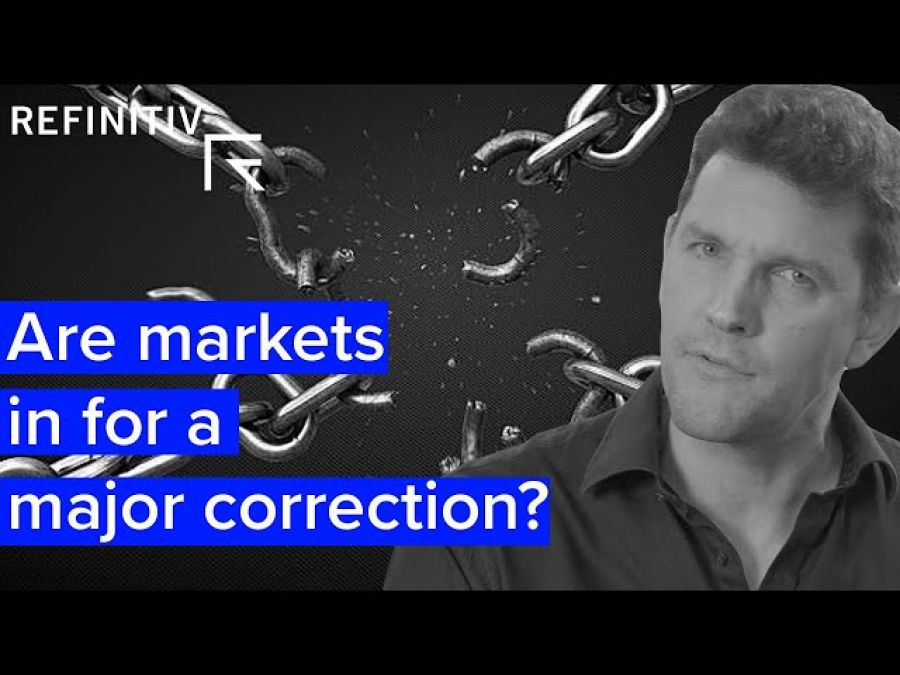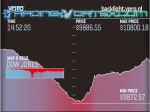Video Transcription:
Will Bonds Break the Bull? | The Big Conversation | Refinitiv
ROGER HIRST: The ongoing dislocation between valuation and earnings has led many investors to question the very nature of the equity market and wonder what could be a catalyst for future weakness. Higher bond yields probably seem very unlikely in the current environment, but many believe that yields are still one of the biggest threats to this framework. And that's the big conversation. When investors are hunting for a top in equity markets, they're usually on the lookout for a catalyst, and valuation itself is not a reason for a top. Markets can and do stay over and undervalued for very long periods of time. And currently we have seen an extended period in which the median equity within the US is more overvalued than at any other time in history. The S&P was more overvalued in 2000, but that was a period defined by a very small number of incredibly expensive tech names. Today, the broad market is at an extreme. Although overvaluation is often a condition that we see at market tops, it is not itself the reason for a reversal. Active investors have been underperforming the broad market for a number of years, and some analysts have calculated that the stock of active funds has now been overtaken by the stock of passive funds. And this is a trend that shows very little sign of abating. So has the investment framework therefore changed? Well, central bank liquidity over the last decade has been responsible for the hunt for yield and the dampening of volatility in macro data, in asset performance and in asset prices themselves. Investment mandates have followed these trends and flows have increasingly been allocated to passive and rules based funds. I think it's worth making a sort of distinction here. When we refer to passive funds, many perceive it just index funds and ETF. But I would include rules based funds investing in this category and rules based investing comes under a myriad of names such as risk parity or minimum volatility to name but two of the very, very many types and styles that are out there. These funds are model based and they dispassionately follow their investment rules. They don't have emotions. They do not do surveys. And therefore, many of the sentiment indicators that we've all historically used are irrelevant to these funds, which are increasingly dominating the longer term investing landscape. And I think the size of this community is probably even larger than many people realize. A couple of years ago, when I was working as a macro derivative strategist in an investment bank, most of the new funds being gathered across, for instance, northern Europe were heading into multi asset funds. And how do these funds operate? And clearly there are,as mentioned, a very, very large number of styles, but many of them will use inputs such as yield and volatility as their guides. Now, what I'm going to talk about here is intentionally oversimplistic, but for instance, levels of realized volatility can often define the level of equity allocation within these funds. Some funds, for instance, may use something like a three month, which is about 100 day, realized volatility as an input. That's the actual historical volatility of, for instance, an equity index rather than the implied volatility, which is a market price and realized volatility bands may set the equity allocation. And what I mean by that is, for example, if realized volatility is under 16, a fund may well be increasing its equity allocation. If realized volatility is, say, below 12 or lower, then they may be adding equity at the maximum allocation that their model allows. And if realized volatility is above 16, then the fund may become at that point a net seller of equity. As mentioned, this is really just to give a very rough idea, but it also helps to explain why each selloff has so far not morphed into anything deeper. When we had volmageddon in February 2018, these funds would still have been buyers into the dip because three month realized volatility takes time to rise. It has a lag and most probably these types of funds would also have been sellers of volatility into that spike. This is implied volatility and in effect this becomes a stabilizing mechanism and although realized volatility did eventually pick up and did reach the trigger point of 16 and above, this was with a lag and by then the central banks had already reacted with more easing and more liquidity, which then helps fuel the other great structural support of the market, which is the corporate buyback. And one of the features of markets, particularly the second half of the last decade, was the speed with which equity markets, particularly in the US, recovered after each period of contagion. The markets are certainly come close to catastrophe on a couple of occasions, with many analysts suggesting that the S&P 500 came within probably a couple of 100 points of a major sell trigger near those lows in late 2018. This is why many people are looking towards the bond market, thinking that yields maybe that trigger that eventually break the market framework. But so far, bonds have generally provided a stabilizing influence by rallying, that’s when yields are falling, when the equity market has had a significant sell off. But in late 2018, it was arguably the bond market that triggered that fourth quarter decline. The US 10 year yield had increased to around about 3.25 percent shortly ahead of the S&P rolling over, and this gives some idea of where yields may need to go in order to undermine equities in the current framework. And the question is, what would take yields higher from here? Well, the manipulated inflation figures have been stable for an extended period of time, though almost everybody has a story or an experience of inflation that is painfully higher than the headlines would suggest. But for yields, we don't actually need inflation itself to pick up, just the expectation of inflation. Term premiums, and this is sort of the additional amount on longer dated bond yields that represent the inflation risk. Well, they have been extremely depressed in terms of their absolute level. But if they start to turn, then yields could catch light. The year on year surge in the Fed's balance sheet suggests that there are significant risks of a steeper yield curve and of higher absolute yields. And as we've discussed before, steepening of the yield curve has occurred ahead of the last few U.S. recessions. But on those occasions, those previous occasions, the curve is steepening because front end yields were falling due to the Federal Reserve cutting rates. But nonetheless, the impact could be the same this time round. Significantly higher yields would impact many of the rules based funds, especially if the move in the yields was very sudden. But speculative positioning in bond futures is still, however, generally on the short side. We also know that there is still pent up demand for bonds due to the massive unfunded liabilities that exist across the whole of the developed world's pension system and the average hourly earnings in last week's job numbers weren't exactly pointing to an imminent surge in inflation. Data either was a bigger threat to equities in the short term is more likely to come from the Fed withdrawing some of its emergency liquidity measures. But if we're looking for a protracted decline in the equity market rather than just another short, sharp shock, then higher yields, steeper curves and higher volatility in the bond market are a very credible threat to this new investment framework. A hedge within the equity space could be a short position or preferably maybe put options on things like the US utility sector. And this is a sector that has been in an upward trend, a very clear one along with the rest of the US equity market over the last 10 years. But when yields surge, this sector usually starts to struggle in both relative and absolute terms. And on the bond market itself? Well, no one is gonna be too concerned as long as US 10-year yields are below the 2 percent level. But if that hurdle is cleared, and especially if that also comes with higher level of realized equity volatility, then at that point it will be a good time to start thinking about hedging for a shift in the investment framework by buying some medium term protection on equity markets. There's always a lot of chatter around reporting season. 2019 was pretty much a lacklustre year, we're still waiting for Q4 to come out, obviously, but full year earnings are expected to grow by just 1 percent compared to 24 percent in 2018, according to Refinitiv data. 2019 will be the worst year since the earnings recession of 2015, and fourth quarter earnings are expected to fall by 0.6 percent. And this maintains the recent trend of flat earnings, even as U.S. equities have soared, in fact, last year, equity performance was all about the recovery off the 2018 lows and then a Federal Reserve driven multiple expansion that saw equity prices soar away from underlying profitability. According to Goldman Sachs, 92 percent of S&P returns last year were attributable to higher valuations with only 8 percent were due to earnings growth. And ever the optimists, Wall Street analysts think that corporate profits will rebound in 2020 by nearly 10 percent, with 90 percent of companies in the S&P expected to have positive earnings and positive revenue growth. But even a 10 percent bounce will leave the market at historically elevated valuation levels. And also, is the optimism of an earnings rebound misplaced? Analysts have already cut forecasts in 10 of the 15 companies that have reported fourth quarter earnings, including big names such as Nike and FedEx. And this is following that well trodden path ahead of almost every earnings season in which estimates start high and then a walk down into the actual results, which then miraculously beat expectations. And by way of example, Q4 2019 earnings, which are now expected to drop by nought point six percent, were forecast to grow by eleven point eight percent in November 2018. So in terms of what to look out for in the season, energy, consumer discretionary and industrial earnings are expected to drop the most. But does any of this really matter when buybacks and Federal Reserve liquidity have been the key drivers? And this is where earnings may actually matter. Firstly, with earnings season comes the buyback blackout period. This is where companies are not allowed to buy the shares for a short period of time ahead of their reporting. And we are currently in that blackout period. So the U.S. market has temporarily lost one of its key supports. But this all comes at a time when the Fed have to decide whether they will step back from the short term liquidity operations. The last of the emergency year end facilities ended on January the 14th, and last week, the Fed's balance sheet contracted for only the second time since emergency repo operations began in September 2019. And the last time the Fed balance sheet declined also saw the S&P 500 decline on a week by week basis, and that was back in November. So given that we're entering earnings season with the S&P at an all time high, this could actually be an extremely sensitive period for equities if earnings miss. The Fed is stepping back and we're still deep into that buyback blackout period. And remember those charts from last week in which 2019 looks just like 2013 and 2014 started off with a wobble in late January. Remember, 2019 also looks like 1999. And the S&P 500 also struggled in the early part of 2000 before making a final high in April of that year. And who of us can forget the Volmageddon of February 2018 where we had that big drop? So put buying is like fire insurance are buying protection. You hope you never need it. But this may be a very good time to think about short dated, that's one to two month puts while we navigate through this time of central bank uncertainty during this buyback blackout period. There's been quite a lot of talk about the increased government expenditure and the rise of fiscal policy to complement monetary policy and money printing. But what will the fiscal expenditure in the future look like? What's the size going to be and where are these likely to take place? Existing monetary policy has failed to meaningfully create economic growth or inflation, with cash mainly finding its way into asset price inflation or non-productive consumer inflation. Now, we may already have seen peak bonds when last year we saw nearly 17 trillion in global yields fall into negative territory. But global interest rates are expected to remain close to the lows well into 2021, with only a handful of emerging markets expect to have interest rates anywhere significantly above 2 percent. And governments will not want to wait until those yields move significantly higher before they embark on their spending sprees. Christine Lagharde has been installed at the head of the ECB to try and coerce Europe's leadership into spending on projects and providing the ECB with yet more bonds to buy. And Germany may well be more predisposed towards financial profligacy, given the current weakness in global manufacturing. The UK government has also committed to a high level of expenditure than has historically been the norm for conservative governments. In fact, this party looks likely to break with over 50 years of tradition in which the conservatives usually cut government expenditures. What are the sorts of projects that governments may undertake and what sort of scale should we expect? Well, the big daddy of infrastructure projects is obviously China's belt and road with two thousand eight hundred eighty one individual projects and a value completion of around about three point four five trillion US dollars, according to Refinitiv data. And just over half of those projects involve non Chinese companies. The Asian Development Bank estimates that the region has a funding gap of one point seven trillion per year until 2030. The global infrastructure hub estimates the global infrastructure gap is at 15. That's one-five trillion dollars between now and 2040, whilst McKinsey estimate a three point seven trillion requirement per year until 2035. So will 2020 be the year that infrastructure emerges as an asset class in its own right rather than being lumped into the alternative bucket? Clearly, these projects are very long term and this is not an asset class that can be switched on quickly. The UK should be an early mover to anyone who's witnessed the UK's attempts to build an extra runway at Heathrow or a high speed railing from London to Birmingham know that British bureaucracy will continue to be a drag, but from an investment perspective, whilst people may focus on things like construction companies, that's going to be a little bit of a hit and miss strategy. But what fiscal expenditures should do is shift the inflation risks to the upside. And this should therefore have an impact on bond yields. The long end of the UK market is still very low compared to its historical performance versus the US, although the absolute levels will be defined by the broader growth outlook. The potential for the UK government to come out swinging the bat should help steepen the UK yield curve and help 10-year yields close that gap to the US equivalent.








